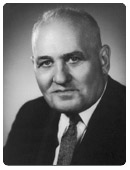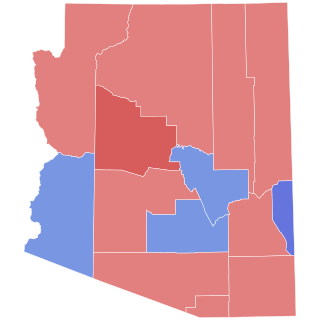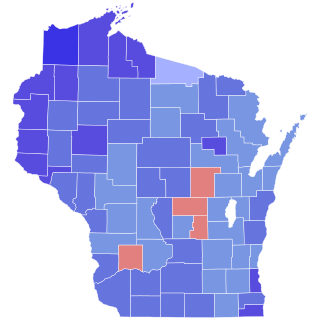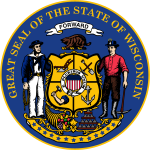
The 1976 United States Senate elections was an election for the United States Senate. Held on November 2, the 33 seats of Class 1 were contested in regular elections. They coincided with Democrat Jimmy Carter's presidential election and the United States Bicentennial celebration. Although almost half of the seats decided in this election changed parties, Carter's narrow victory did not provide coattails for the Democratic Party.

The 1964 United States Senate elections were held on November 3. The 33 seats of Class 1 were contested in regular elections. Special elections were also held to fill vacancies. They coincided with the election of President Lyndon B. Johnson by an overwhelming majority, to a full term. His Democratic Party picked up a net two seats from the Republicans. As of 2022, this was the last time either party has had a two-thirds majority in the Senate, which would have hypothetically allowed the Senate Democrats to override a veto, propose constitutional amendments, or convict and expel certain officials without any votes from Senate Republicans. In practice, however, internal divisions effectively prevented the Democrats from doing so. The Senate election coincided with Democratic gains in the House in the same year.

Thomas Edward Fairchild was an American lawyer and judge. He served forty years as a judge of the United States Court of Appeals for the Seventh Circuit. Earlier in his career he was a justice of the Wisconsin Supreme Court, United States Attorney for the Western District of Wisconsin, and the 31st Attorney General of Wisconsin.
Roland Bernard Day was an American lawyer, politician, and jurist. He was the 24th Chief Justice of the Wisconsin Supreme Court, in 1995 and 1996, after a 22-year career on the court.

The Ohio general elections, 2010 were held on November 2, 2010 throughout Ohio. Primary elections took place on May 4, 2010.

Roland Joseph Steinle was an American lawyer, jurist, and Republican politician from the U.S. state of Wisconsin. He served four years on the Wisconsin Supreme Court and was the Republican nominee for United States Senator from Wisconsin in the 1958 election.

The 1932 United States Senate election in Washington was held on November 8, 1932. Incumbent Republican U.S. Senator Wesley Livsey Jones ran for a fifth term in office, but was defeated by former State Representative Homer Bone.

The 1958 United States Senate elections in Arizona took place on November 4, 1958. Incumbent Republican U.S. Senator Barry Goldwater ran for reelection to a second term, and defeated former U.S. Senator, and then-Governor, Ernest McFarland in the general election. The election was a rematch from 1952, where Goldwater defeated McFarland by a narrow margin. Goldwater had attributed the 1952 win to the unpopularity of President Harry S. Truman and popular Wisconsin Senator Joseph McCarthy endorsing his campaign.

The 1930 United States Senate election in Montana took place on November 4, 1930. Incumbent United States Senator Thomas J. Walsh, who was first elected to the Senate in 1912, and re-elected in 1918 and 1924, ran for re-election. He won the Democratic primary unopposed, and faced Montana Supreme Court Associate Justice Albert J. Galen, the Republican nominee, and several independent opponents in the general election. Ultimately, Walsh defeated his opponents in a landslide and won his fourth and final term in the Senate.

The 1938 United States Senate election in Ohio took place on November 7, 1938. Incumbent Senator Robert J. Bulkley ran for re-election to a second full term in office, but was defeated by the Republican nominee, former state Senator Robert A. Taft, the elder son of former President and supreme court chief justice William Howard Taft. Taft's victory was a part of a major Republican wave nationally, where Republicans gained 8 Senate seats and 81 seats in the House of Representatives, which was largely attributable to incumbent Democratic President Franklin Roosevelts's unpopularity in the aftermath of the Recession of 1937–1938 and the President's controversial plan to add more seats to the Supreme Court, which he proposed after the court ruled some of his New Deal programs unconstitutional. Taft's victory marked the beginning of 4 consecutive Republican victories in this seat, and Democrats would not win it again until Governor Frank Lausche won it in 1956.

The United States Senate election of 1926 in New York was held on November 2, 1926. Incumbent Republican Senator James Wolcott Wadsworth Jr. ran for re-election to a third term, but was defeated by Democrat Robert F. Wagner.

The 1942 United States Senate election in Colorado took place on November 3, 1942. Incumbent Democratic Senator Edwin C. Johnson was re-elected to second term over Republican Governor Ralph L. Carr.

The 1952 United States Senate election in Wisconsin was held on November 4, 1952.

The 1964 United States Senate election in Wisconsin was held on November 3, 1964. Incumbent Democrat William Proxmire was re-elected to a second term in office over Republican Wilbur Renk.

The 1982 United States Senate election in Wisconsin was held on November 2, 1982. Incumbent Democrat William Proxmire defeated Republican nominee Scott McCallum in a landslide, taking 63.65% of the vote to McCallum's 34.14%.

The 1970 United States Senate election in Wisconsin was held on November 3, 1970. Incumbent Democrat William Proxmire was easily re-elected to a third term in office over Republican John E. Erickson, taking more than 70% of the vote, and defeating Erickson by more than 42 percentage points.

The 2016 Wisconsin Fall General Election was held in the U.S. state of Wisconsin on November 8, 2016. One of Wisconsin's U.S. Senate seats and all eight seats in the United States House of Representatives are up for election, as well as half of the Wisconsin Senate seats and all of the Wisconsin Assembly seats. The 2016 Fall Partisan Primary was held on August 9, 2016.

The 1966 United States Senate election in Delaware took place on November 8, 1966. Incumbent Republican U.S. Senator J. Caleb Boggs was re-elected to a second term in office. As of 2022, this is the last time a Republican has won Delaware’s Class 2 Senate seat.
Democrat William Proxmire won a special election to fill the vacancy created by the death of Senator Joseph R. McCarthy (R-WI). Also, Price Daniel (D-TX) left the Senate to become governor of Texas, and Democrat Ralph Yarborough won a special election for that Senate seat. The Democrats thus made a net gain of one seat. However, Congress was out of session at the time of the Democratic gain in Wisconsin, and the Republicans gained a Democratic-held seat only weeks after the next session started, when Republican John D. Hoblitzell Jr. was appointed to fill the vacancy created by the death of Senator Matthew M. Neely (D-WV).

The 2000 Wisconsin Fall General Election was held in the U.S. state of Wisconsin on November 7, 2000. One of Wisconsin's U.S. Senate seats was up for election, as well as Wisconsin's nine seats in the United States House of Representatives, the sixteen even-numbered seats in the Wisconsin State Senate, and all 99 seats in the Wisconsin State Assembly. Voters also chose eleven electors to represent them in the Electoral College, which then participated in selecting the president of the United States. The 2000 Fall Partisan Primary was held on September 12, 2000.

















